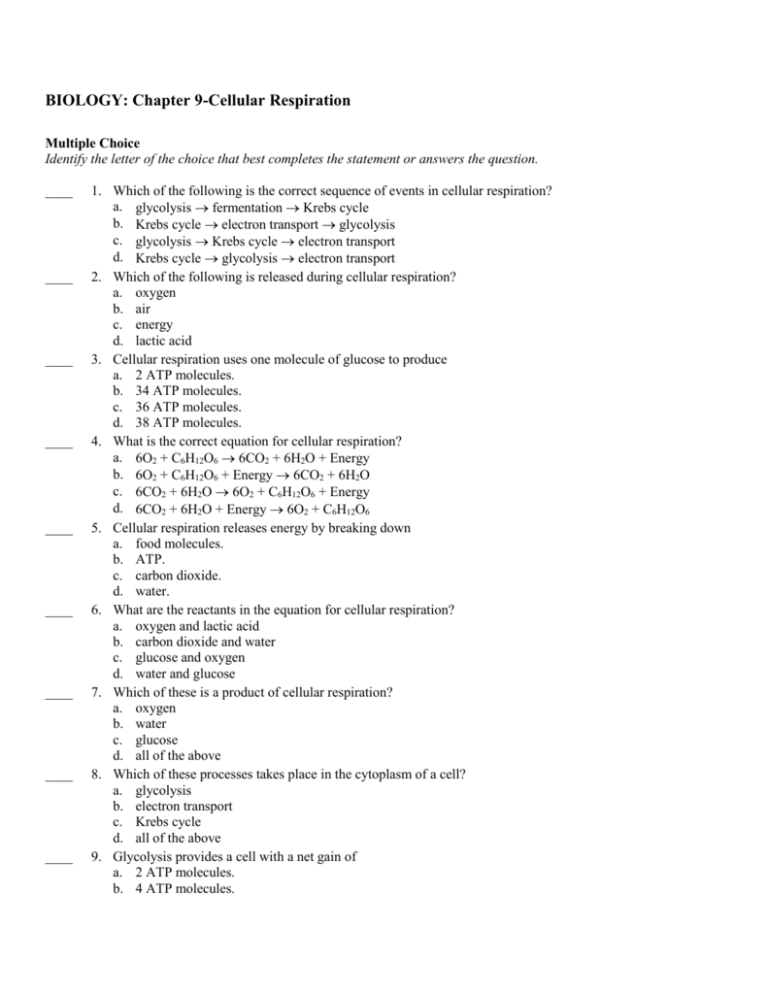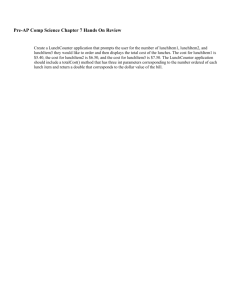Cellular Respiration Test - Biology High School
advertisement

BIOLOGY: Chapter 9-Cellular Respiration Multiple Choice Identify the letter of the choice that best completes the statement or answers the question. ____ ____ ____ ____ ____ ____ ____ ____ ____ 1. Which of the following is the correct sequence of events in cellular respiration? a. glycolysis fermentation Krebs cycle b. Krebs cycle electron transport glycolysis c. glycolysis Krebs cycle electron transport d. Krebs cycle glycolysis electron transport 2. Which of the following is released during cellular respiration? a. oxygen b. air c. energy d. lactic acid 3. Cellular respiration uses one molecule of glucose to produce a. 2 ATP molecules. b. 34 ATP molecules. c. 36 ATP molecules. d. 38 ATP molecules. 4. What is the correct equation for cellular respiration? a. 6O2 + C6H12O6 6CO2 + 6H2O + Energy b. 6O2 + C6H12O6 + Energy 6CO2 + 6H2O c. 6CO2 + 6H2O 6O2 + C6H12O6 + Energy d. 6CO2 + 6H2O + Energy 6O2 + C6H12O6 5. Cellular respiration releases energy by breaking down a. food molecules. b. ATP. c. carbon dioxide. d. water. 6. What are the reactants in the equation for cellular respiration? a. oxygen and lactic acid b. carbon dioxide and water c. glucose and oxygen d. water and glucose 7. Which of these is a product of cellular respiration? a. oxygen b. water c. glucose d. all of the above 8. Which of these processes takes place in the cytoplasm of a cell? a. glycolysis b. electron transport c. Krebs cycle d. all of the above 9. Glycolysis provides a cell with a net gain of a. 2 ATP molecules. b. 4 ATP molecules. ____ 10. ____ 11. ____ 12. ____ 13. ____ 14. ____ 15. ____ 16. ____ 17. ____ 18. ____ 19. c. 18 ATP molecules. d. 36 ATP molecules. The starting molecule for glycolysis is a. ADP. b. pyruvic acid. c. citric acid. d. glucose. Which of the following is NOT a product of glycolysis? a. NADH b. pyruvic acid c. ATP d. glucose Which of the following acts as an electron carrier in cellular respiration? a. NAD+ b. pyruvic acid c. ADP d. ATP Lactic acid fermentation occurs in a. bread dough. b. any environment containing oxygen. c. muscle cells. d. mitochondria. The two main types of fermentation are called a. alcoholic and aerobic. b. aerobic and anaerobic. c. alcoholic and lactic acid. d. lactic acid and anaerobic. Which process is used to produce beer and wine? a. lactic acid fermentation b. glycolysis c. alcoholic fermentation d. the Krebs cycle In the presence of oxygen, glycolysis is followed by a. lactic acid fermentation. b. alcoholic fermentation. c. photosynthesis. d. the Krebs cycle. Cellular respiration is called an aerobic process because it requires a. light. b. exercise. c. oxygen. d. glucose. The starting molecule for the Krebs cycle is a. glucose. b. NADH. c. pyruvic acid. d. coenzyme A. The Krebs cycle does not occur if a. oxygen is present. ____ 20. ____ 21. ____ 22. ____ 23. ____ 24. ____ 25. ____ 26. ____ 27. ____ 28. b. fermentation occurs. c. glycolysis occurs. d. carbon dioxide is present. The Krebs cycle starts with a. lactic acid and yields carbon dioxide. b. glucose and yields 32 ATPs. c. pyruvic acid and yields lactic acid or alcohol. d. pyruvic acid and yields carbon dioxide. In eukaryotes, electron transport occurs in the a. mitochondria. b. chloroplasts. c. cell membrane. d. cytoplasm. The energy of the electrons passing along the electron transport chain is used to make a. lactic acid. b. citric acid. c. alcohol. d. ATP. The energy needed to win a 30 second sprint is produced mostly by a. lactic acid fermentation. b. cellular respiration. c. using up stores of ATP. d. breaking down fats. All of the following are sources of energy during exercise EXCEPT a. stored ATP. b. alcoholic fermentation. c. lactic acid fermentation. d. cellular respiration. Which process does NOT release energy from glucose? a. glycolysis b. photosynthesis c. fermentation d. cellular respiration How are cellular respiration and photosynthesis almost opposite processes? a. Photosynthesis releases energy, and cellular respiration stores energy. b. Photosynthesis removes carbon dioxide from the atmosphere, and cellular respiration puts it back. c. Photosynthesis removes oxygen from the atmosphere, and cellular respiration puts it back. d. all of the above Photosynthesis is to chloroplasts as cellular respiration is to a. chloroplasts. b. cytoplasm. c. mitochondria. d. nuclei. Plants cannot release energy from glucose using a. glycolysis. b. photosynthesis. c. the Krebs cycle. d. cellular respiration. ____ 29. The products of photosynthesis are the a. products of cellular respiration. b. reactants of cellular respiration. c. products of glycolysis. d. reactants of fermentation. True/False Indicate whether the sentence or statement is true or false by marking A for true and B for false Figure 9-1 ____ 30. The pathway labeled A in Figure 9-1 is called glycolysis. ______________________________ ____ 31. If carbon dioxide is present, the pathway labeled C in Figure 9-1 usually will occur. _________________________ Completion Complete each sentence or statement. 32. Without oxygen, a cell can extract a net gain of only ____________________ molecules of ATP from each glucose molecule. a. 0 b. 2 c. 4 d. 6 e. 8 33. Glycolysis converts glucose into two molecules of _________________________. a. lactic acid b. alcohol c. NADH d. pyruvic acid Figure 9-1 34. The pathway labeled B in Figure 9-1 is called ____________________ . a. glycolysis b. cellular respiration c. alcoholic ferementation d. lactic acid fermentation 35. Based on Figure 9-1, ____________________ ATP molecules are formed by fermentation. a. 0 b. 2 c. 4 d. 6 e. 36 36. In Figure 9-1, only the pathway labeled ____________________ requires oxygen. a. A b. B c. C d. none of them need oxygen 37. The Krebs cycle will result in ____________________ ATP molecules. a. 0 b. 2 c. 36 d. 100 e. 20 38. If all autotrophs on Earth suddenly stopped carrying out _________________________, cellular respiration would soon stop too. a. photosynthesis b. lactic acid fermentation c. glycolysis d. the Krebs Cycle Short Answer Figure 9-1 39. Based on Figure 9-1, which type of fermentation does NOT give off carbon dioxide? a. A b. B c. C d. none of them give of carbon dioxide Other USING SCIENCE SKILLS A scientist set up a respiration chamber as shown below. She placed a mouse in flask B. Into flasks A, C, and D, she poured distilled water mixed with the acid-base indicator phenolphthalein. In the presence of CO2, phenolphthalein turns from pink to clear. She allowed the mouse to stay in the chamber for about an hour. Figure 9-2 40. Interpreting Graphics Based on Figure 9-2, how will the scientist be able to detect whether the mouse is carrying out cellular respiration? a. the phenolphthalein in flask A will change from pink to clear. b. the phenolphthalein in flask B will change from pink to clear. c. the phenolphthalein in flask D will change from pink to clear. d. there won’t be a change in any flask 41. Predicting Assume that the scientist set up an identical respiration chamber, except that in this setup she placed a mouse that had been exercising on a hamster wheel. Then, the scientist measured the amount of CO2 given off by both mice at the end of 15 minutes. Predict which setup produced the most CO2. a. the mouse not exercising produces more CO2. b. the mouse exercising produces more CO2. c. you can’t conclude which mouse will produce more CO2. USING SCIENCE SKILLS A student poured a solution of bromthymol blue indicator into three test tubes. Then, he placed an aquatic plant in two of the test tubes, as shown below. He placed a stopper on each test tube and placed them all in the dark for 24 hours. Bromthymol blue turns from blue to yellow in the presence of CO2. Figure 9-4 42. Applying Concepts Look at Figure 9-4. Which process or processes would you expect the organisms in the test tubes to carry out—cellular respiration? a. only 1 b. 1 & 2 c. 2 & 3 d. only 3 43. Inferring Which process or processes would you expect the organisms in the test tubes to carry out— photosynthesis? a. only 1 b. 1 & 2 c. 2 & 3 d. only 3 44. After 24 hours, which test tube(s) will be yellow? a. all of them b. only 2 c. only 3 d. both 2 & 3 BIOLOGY: Chapter 9-Cellular Respiration Answer Section MULTIPLE CHOICE 1. 2. 3. 4. 5. 6. 7. 8. 9. 10. 11. 12. 13. 14. 15. 16. 17. 18. 19. 20. 21. 22. 23. 24. 25. 26. 27. 28. 29. ANS: ANS: ANS: ANS: ANS: ANS: ANS: ANS: ANS: ANS: ANS: ANS: ANS: ANS: ANS: ANS: ANS: ANS: ANS: ANS: ANS: ANS: ANS: ANS: ANS: ANS: ANS: ANS: ANS: C C C A A C B A A D D A C C C D C C B D A D A B B B C B B PTS: PTS: PTS: PTS: PTS: PTS: PTS: PTS: PTS: PTS: PTS: PTS: PTS: PTS: PTS: PTS: PTS: PTS: PTS: PTS: PTS: PTS: PTS: PTS: PTS: PTS: PTS: PTS: PTS: 1 1 1 1 1 1 1 1 1 1 1 1 1 1 1 1 1 1 1 1 1 1 1 1 1 1 1 1 1 MODIFIED TRUE/FALSE 30. ANS: F, lactic acid fermentation PTS: 1 31. ANS: F, oxygen PTS: 1 COMPLETION 32. ANS: b. 2 PTS: 1 33. ANS: d. pyruvic acid PTS: 1 34. ANS: c. alcoholic PTS: 1 35. ANS: b. 2 PTS: 1 36. ANS: c. C PTS: 1 37. ANS: b. 2 PTS: 1 38. ANS: a. photosynthesis PTS: 1 SHORT ANSWER 39. ANS: a. A PTS: 1 OTHER 40. ANS: a. flask A will change PTS: 1 41. ANS: b. mouse exercising PTS: 1 42. ANS: c. 2 & 3 PTS: 1 43. ANS: c. 2 & 3 PTS: 1 ESSAY 44. ANS: d. both 2 & 3 PTS: 1








